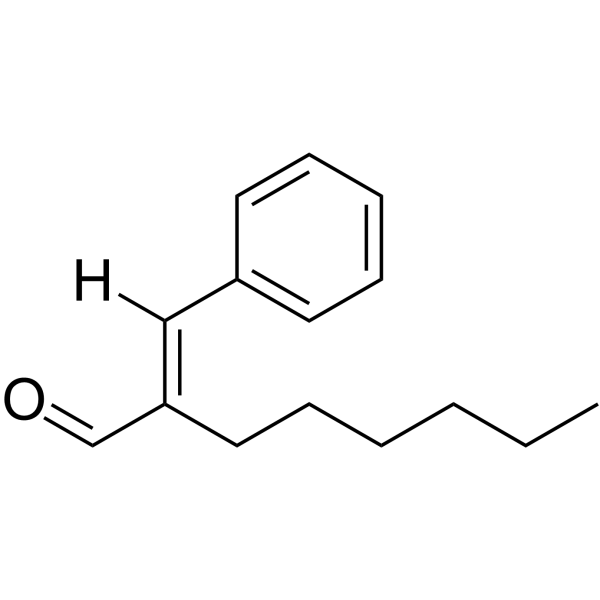α-己基肉桂醛

α-己基肉桂醛结构式

|
常用名 | α-己基肉桂醛 | 英文名 | Hexyl cinnamaldehyde |
|---|---|---|---|---|
| CAS号 | 101-86-0 | 分子量 | 216.319 | |
| 密度 | 1.0±0.1 g/cm3 | 沸点 | 308.1±0.0 °C at 760 mmHg | |
| 分子式 | C15H20O | 熔点 | N/A | |
| MSDS | 中文版 美版 | 闪点 | 140.5±14.6 °C | |
| 符号 |

GHS07 |
信号词 | Warning |
|
Natural ingredients based cosmetics. Content of selected fragrance sensitizers.
Contact Dermatitis 34(6) , 423-6, (1996) In the present study, we have investigated 42 cosmetic products based on natural ingredients for content of 11 fragrance substances: geraniol, hydroxycitronellal, eugenol, isoeugenol, cinnamic aldehyde, cinnamic alcohol, alpha-amylcinnamic aldehyde, citral, c... |
|
|
Evaluation of an ex vivo murine local lymph node assay: multiple endpoint comparison.
J. Appl. Toxicol. 26(4) , 333-40, (2006) The local lymph node assay (LLNA) is used to assess the skin sensitization potential of chemicals. In the standard assay, mice are treated topically on the dorsum of both ears with test substance for 3 days. Following 2 days of rest, the initiation of the hyp... |
|
|
Patch testing with a new fragrance mix detects additional patients sensitive to perfumes and missed by the current fragrance mix.
Contact Dermatitis 52(4) , 207-15, (2005) The currently used 8% fragrance mix (FM I) does not identify all patients with a positive history of adverse reactions to fragrances. A new FM II with 6 frequently used chemicals was evaluated in 1701 consecutive patients patch tested in 6 dermatological cent... |
|
|
Patch testing with a new fragrance mix - reactivity to the individual constituents and chemical detection in relevant cosmetic products.
Contact Dermatitis 52(4) , 216-25, (2005) A new fragrance mix (FM II), with 6 frequently used chemicals not present in the currently used fragrance mix (FM I), was evaluated in 6 dermatological centres in Europe, as previously reported. In this publication, test results with the individual constituen... |
|
|
Comparison of sex differences in guinea-pig maximization test for detection of skin-sensitizing potential using OECD recommended positive control sensitizers.
J. Toxicol. Sci. 23(2) , 105-11, (1998) Both male and female guinea pigs are widely used in tests to detect the skin-sensitizing potential of new chemicals. The aim of the present study was to investigate the influence of the animal gender on sensitization rates, with the guinea-pig maximization te... |
|
|
[Improvement of local lymph node assay for cosmetics safety evaluation].
Wei Sheng Yan Jiu 38(5) , 585-9, (2009) To improve the local lymph node assay (LLNA) as an alternative method to detect chemicals for both sensitization and irritation.The following chemicals: one negative control: 4-Aminobenzoic Acid, three sensitizers: 2,4-dinitrochlorobenzene (DNCB), Hexyl cinna... |
|
|
The suitability of hexyl cinnamic aldehyde as a calibrant for the murine local lymph node assay.
Contact Dermatitis 44(6) , 357-61, (2001) The murine local lymph node assay (LLNA) for the prospective identification of contact allergens assesses skin sensitization potential as a function of proliferative activity induced in lymph nodes draining the site of topical exposure to test chemical. This ... |
|
|
Results with OECD recommended positive control sensitizers in the maximization, Buehler and local lymph node assays.
Food Chem. Toxicol. 31(1) , 63-7, (1993) The guinea pig maximization test and the Buehler occluded patch test are used widely to identify the sensitization potential of new chemicals. This information enables toxicologists and/or regulatory authorities to determine whether a chemical should be class... |
|
|
Comparison of mouse strains using the local lymph node assay.
Toxicology 146(2-3) , 221-7, (2000) The local lymph node assay (LLNA), as recommended by the Interagency Coordinating Committee on the Validation of Alternative Methods (ICCVAM), only allows for the use of CBA mice. The objective of these studies was to begin to assess the response of chemical ... |
|
|
The skin sensitization potential of resorcinol: experience with the local lymph node assay.
Contact Dermatitis 56(4) , 196-200, (2007) Resorcinol is a simple aromatic chemical (1,3-benzenediol) that has found widespread use, particularly as a coupler in hair dyes. Clinical experience clearly shows that resorcinol is a (albeit uncommon) skin sensitizer. By contrast, predictive methods, both a... |